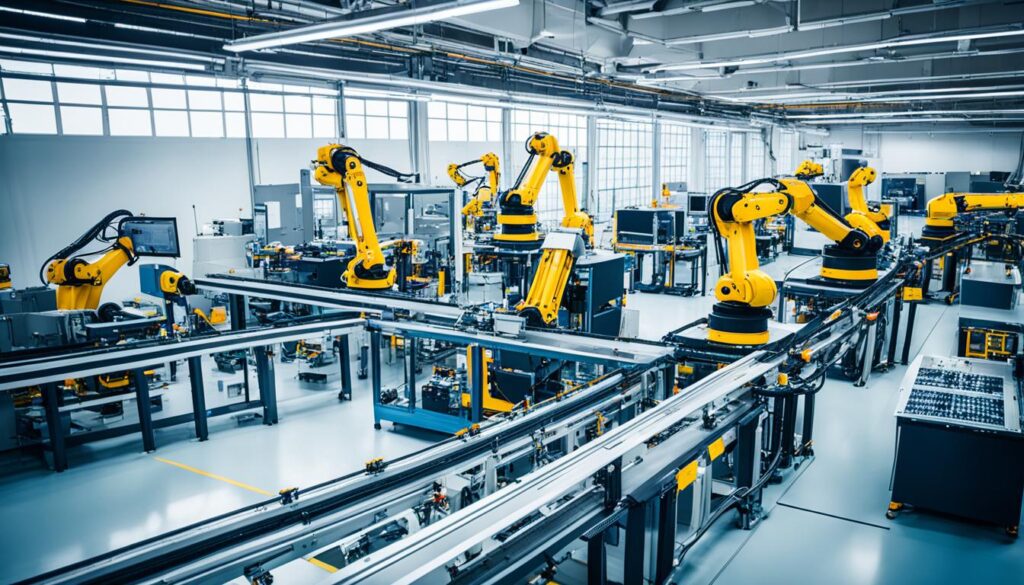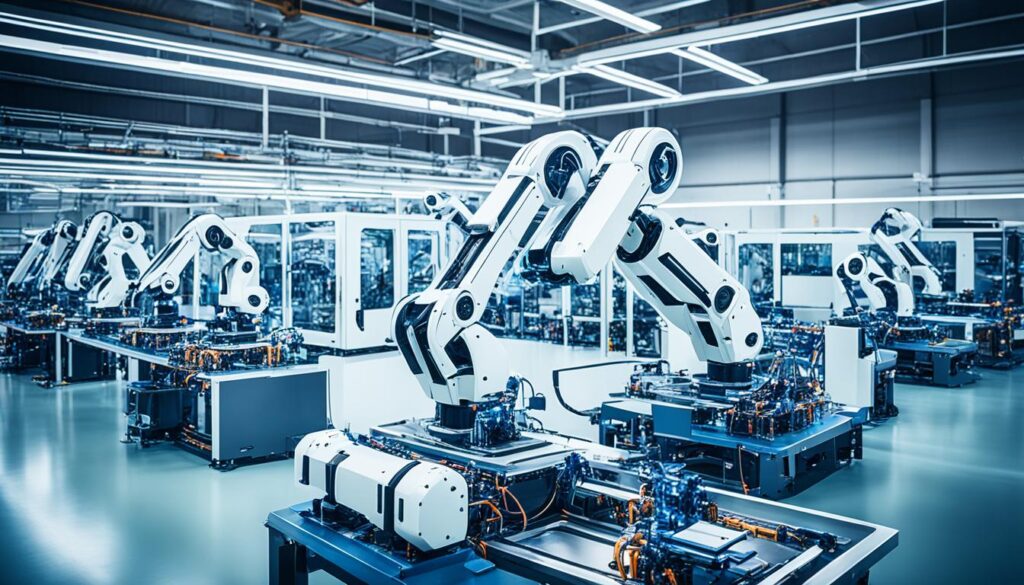In the rapidly evolving digital landscape, automation has emerged as a game-changer for businesses seeking to boost productivity and drive sustainable growth. According to the data, automation is a critical capability for companies looking to transform digitally and enhance efficiency across every department. By leveraging advanced technologies, organizations can now automate repetitive tasks, trigger real-time automations based on customer behavior or market conditions, and harness the power of artificial intelligence (AI) to learn, adapt, and make data-driven decisions.
Paired with AI, automation enables organizations to deliver highly personalized customer experiences at scale while driving higher levels of productivity and operational excellence. This powerful combination of real-time data, automation, and AI allows companies to optimize their processes, reduce costs, and enhance their overall competitiveness in the market.
Key Takeaways
- Automation is a critical capability for digital transformation and improving efficiency across all business functions.
- Real-time data, automation, and AI enable organizations to deliver personalized customer experiences at scale.
- Automation and AI-driven systems can perform repetitive tasks, learn, adapt, and make data-driven decisions.
- Automation and AI-powered solutions drive productivity, cost reduction, and operational excellence.
- Leveraging automation and AI technologies is essential for businesses seeking to enhance their competitiveness in the market.
Embracing Automation: The Key to Efficiency and Growth
Businesses today face an array of challenges, from persistent inflation and supply chain disruptions to market volatility and looming recession fears. In this competitive landscape, companies must find ways to achieve more with the resources at their disposal. Automation has emerged as a crucial tool in this quest, offering a path to improved productivity, efficiency, and operational excellence.
Automation is no longer a mere “nice-to-have” – it has become a must-have for businesses seeking to stay ahead. By automating repetitive and monotonous tasks, companies can reduce error rates, enhance compliance, and free up their teams to focus on more strategic, value-driven work. This, in turn, leads to better customer experiences and a reduction in employee stress – a critical factor in today’s shifting labor market, where retaining top talent is paramount.
The Pressures Facing Modern Businesses
- Persistent inflation and supply chain disruptions
- Volatile market conditions and recession fears
- The need to achieve more with limited resources
Automation: From Nice-to-Have to Must-Have
- Reduces repetitive and monotonous tasks
- Improves compliance and data-driven insights
- Enhances customer experiences and employee satisfaction
- Helps combat burnout and improve work-life balance
“Automation is no longer a luxury – it’s a necessity for businesses looking to thrive in today’s volatile and uncertain environment.”

By embracing automation, companies can unlock a world of productivity improvements, efficiency gains, and process optimization, ultimately driving cost reduction and scalability. With human-machine collaboration at the forefront, businesses can harness the power of data-driven insights to make informed decisions and achieve new levels of operational excellence.
The Benefits of Automation: Unlocking Productivity Gains
As businesses strive to boost efficiency and drive growth, the power of automation cannot be overstated. Recent studies have shown that automation can unlock significant productivity gains, revolutionizing the way organizations operate. From streamlining workflows to enhancing employee satisfaction, the benefits of embracing automation are far-reaching.
Real-Time Data and Personalized Experiences
Automation empowers businesses to harness the power of real-time data, enabling them to make informed decisions and deliver personalized experiences to their customers. By automating repetitive tasks and data-driven processes, companies can free up their teams to focus on more strategic initiatives, driving productivity improvements and efficiency gains.
Enhancing Employee Satisfaction and Retention
Interestingly, automation isn’t just beneficial for the bottom line; it can also have a profound impact on employee satisfaction and retention. According to recent surveys, more than 90% of workers reported that automation solutions increased their productivity, while 85% said these tools boosted collaboration across their teams. Additionally, nearly 90% of employees felt more satisfied with their jobs since they began using automation technology, and 84% were more satisfied with their employer.
By automating tedious and time-consuming tasks, businesses can help their employees achieve a better work-life balance, reducing the risk of burnout and improving employee satisfaction and retention. This, in turn, can contribute to operational excellence and cost reduction, as companies spend less on recruiting and training new talent.

The benefits of automation are clear – from data-driven insights and process optimization to enhanced human-machine collaboration and scalability. As businesses navigate the ever-evolving landscape, embracing automation will be crucial for driving productivity and unlocking new avenues for growth.
how does automation increase productivity
Automation has emerged as a powerful tool for businesses seeking to drive productivity and efficiency gains. By automating repetitive, manual tasks, organizations can free up their employees to focus on more strategic, value-added work. This not only improves operational excellence but also enhances the overall employee experience, leading to increased job satisfaction and retention.
One of the key ways automation boosts productivity is by streamlining processes and reducing errors. With real-time data insights and intelligent decision-making capabilities, automated systems can optimize workflows, eliminate bottlenecks, and enable faster, more accurate decision-making. This translates into significant time and cost savings for the business.
Moreover, automation can enhance scalability and operational excellence by ensuring consistent, high-quality outputs regardless of fluctuations in workload or resources. As the business grows, automated systems can seamlessly handle increased volume and complexity, freeing up human employees to focus on strategic initiatives that drive innovation and growth.
Ultimately, the integration of automation and human-machine collaboration unlocks a powerful synergy, where the unique strengths of both technology and human talent are leveraged to achieve productivity improvements and efficiency gains that would be difficult to attain through manual processes alone.
| Automation Benefits | Productivity Impacts |
|---|---|
| Reduced manual, repetitive tasks | Increased employee focus on strategic work |
| Streamlined processes and workflows | Faster decision-making with real-time data |
| Enhanced scalability and operational excellence | Improved cost reduction and process optimization |
| Improved employee satisfaction and retention | Unlocked data-driven insights for strategic planning |
“Automation is not just about replacing humans; it’s about enhancing human capabilities and unlocking new levels of productivity and innovation.”
Scaling Automation: Best Practices for Implementation
Successful implementation of automation within an organization requires a strategic approach that addresses both technological and organizational considerations. According to experts at AI Automation Elite, a leading resource for companies seeking to leverage AI and automation, there are several best practices that can help businesses scale their automation initiatives effectively.
Fostering Business Intimacy and Collaboration
The first step is to develop “business intimacy” by partnering closely with stakeholders across the organization. Technology leaders must work hand-in-hand with business teams to understand their unique needs, pain points, and strategic objectives. This collaborative approach ensures that the chosen automation solutions are tailored to address the most pressing business goals, rather than simply implementing technology for technology’s sake.
Unifying Data for Seamless Automation
Another critical element is unifying data from disparate systems into a centralized platform. By breaking down data silos and creating a single source of truth, businesses can enable personalized experiences, intelligent insights, and seamless automation workflows. This data-driven approach helps organizations make more informed decisions, optimize processes, and drive continuous improvement.
FAQ
How does automation increase productivity?
What are the key benefits of automation?
How do employees benefit from automation?
What are the best practices for scaling automation?
Source Links
- How Automation Drives Business Growth and Efficiency – SPONSOR CONTENT FROM SALESFORCE – https://hbr.org/sponsored/2023/04/how-automation-drives-business-growth-and-efficiency
- How Process Automation Helps in Improving Productivity? – https://bpmapp.com/how-process-automation-helps-in-improving-productivity
- Robots and the Economy: The Role of Automation in Productivity Growth – https://blog.trade.gov/2020/12/22/robots-and-the-economy-the-role-of-automation-in-productivity-growth/

[…] challenges. Unlike theoretical certifications, this program validates your ability to build working automation solutions across three progressive skill […]